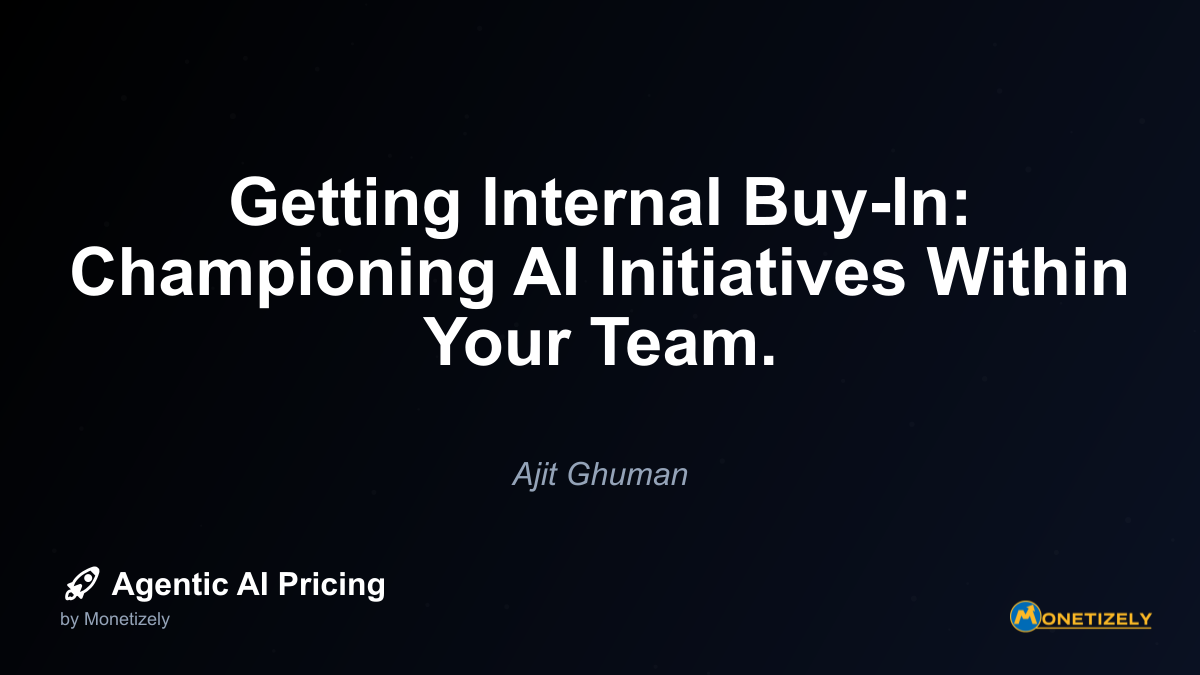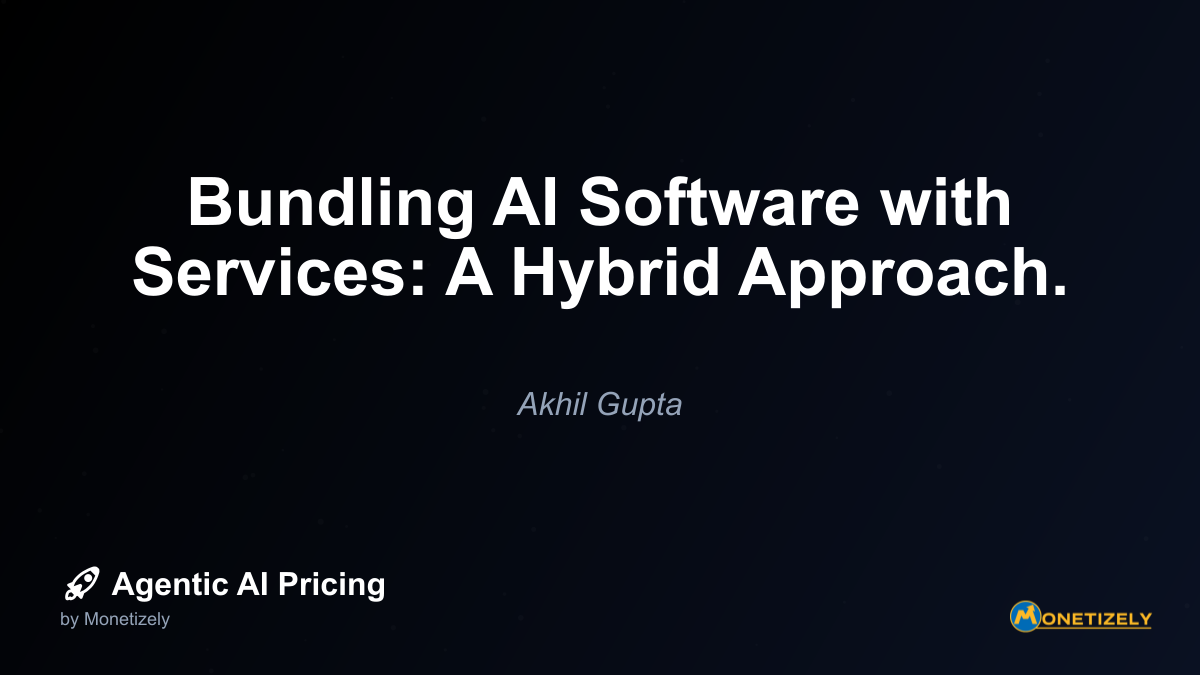· Ajit Ghuman · Strategy & Planning · 7 min read
Getting Internal Buy-In: Championing AI Initiatives Within Your Team.
AI and SaaS Pricing Masterclass
Learn the art of strategic pricing directly from industry experts. Our comprehensive course provides frameworks and methodologies for optimizing your pricing strategy in the evolving AI landscape. Earn a professional certification that can be imported directly to your LinkedIn profile.

Develop a Comprehensive ROI Framework
For AI initiatives, calculating ROI requires a more sophisticated approach than traditional IT projects. Develop a comprehensive framework that accounts for:
Direct Cost Savings
- Labor cost reduction
- Error reduction and quality improvements
- Process efficiency gains
Revenue Enhancement
- Increased conversion rates
- Customer retention improvements
- New revenue streams enabled by AI capabilities
Strategic Value
- Competitive differentiation
- Market positioning benefits
- Future capabilities enabled by the AI foundation
Implementation Costs
- Technology acquisition and development
- Integration with existing systems
- Training and change management
- Ongoing maintenance and improvement costs
For a deeper understanding of AI ROI calculation methodologies, our comprehensive guide on measuring ROI for AI agent implementations provides detailed frameworks and case studies.
Present Multiple Implementation Scenarios
Rather than presenting a single proposal, offer multiple implementation scenarios with different risk-reward profiles:
- Conservative Approach: Lower investment, targeted implementation, modest but highly certain returns
- Balanced Approach: Moderate investment, broader implementation, substantial returns with manageable risk
- Ambitious Approach: Higher investment, comprehensive implementation, transformative potential with higher uncertainty
This approach acknowledges the legitimate concerns about AI investments while demonstrating thoughtful consideration of organizational risk tolerance.
Addressing Technical Team Concerns Effectively
Technical teams often raise the most substantive objections to AI initiatives, particularly regarding implementation feasibility, integration complexity, and maintenance requirements. Dismissing these concerns as “resistance to change” is counterproductive—instead, engage deeply with their expertise.
Involve Technical Teams Early in the Process
Rather than developing a complete proposal before approaching technical stakeholders, involve them in the exploration phase. This collaborative approach yields several benefits:
- Better Solution Design: Technical insights improve the proposed architecture
- Reduced Resistance: Co-creation fosters ownership and commitment
- Realistic Timelines: Implementation challenges are identified early
- Knowledge Transfer: The team builds AI capabilities throughout the process
Address the “Build vs. Buy” Question Transparently
Technical teams often prefer building solutions internally rather than adopting external AI platforms. Acknowledge this preference while facilitating an objective evaluation:
- Document specific capabilities required for success
- Evaluate internal resources and timeline requirements honestly
- Compare total cost of ownership across scenarios
- Consider hybrid approaches that leverage existing technical investments
Provide Clear Answers to Common Technical Objections
Prepare thoughtful responses to the most common technical concerns:
Data Quality and Availability: “How will we ensure the AI has sufficient quality data to perform effectively?”
- Present a data assessment methodology
- Outline data preparation approaches
- Propose incremental implementation aligned with data availability
Integration Complexity: “How will this integrate with our existing systems?”
- Map specific integration points and requirements
- Identify potential API or middleware solutions
- Outline a phased integration approach
Security and Privacy: “What are the security implications of implementing this AI solution?”
- Detail data handling and security protocols
- Address compliance requirements proactively
- Propose governance frameworks for AI usage
Maintenance Burden: “Who will maintain this system once implemented?”
- Outline ongoing resource requirements
- Propose monitoring and maintenance protocols
- Address knowledge transfer and documentation needs
Managing User Representative Concerns and Resistance
User representatives—whether internal teams whose workflows will change or customer advocates concerned about experience impacts—often raise critical concerns about AI implementations. Their perspective is essential for successful adoption.
Emphasize Augmentation Rather Than Replacement
When discussing AI capabilities with user representatives, frame the technology as augmenting human capabilities rather than replacing them. Specifically:
- Highlight how AI handles routine tasks, freeing humans for higher-value work
- Demonstrate how the AI solution improves decision quality through better information access
- Show examples of human-AI collaboration that produces better outcomes than either alone
Involve Users in Solution Design Through Participatory Methods
Rather than presenting a fully-formed solution, engage users in co-creation activities:
- Conduct workflow mapping sessions to identify pain points and opportunities
- Use prototype testing to gather feedback on proposed AI interactions
- Implement feedback loops that demonstrate how user input shapes the solution
- Identify and empower “super users” who can champion the solution with peers
Address Fear of Job Displacement Directly
Concerns about job displacement are legitimate and should be addressed transparently:
- Be honest about how roles will evolve with AI implementation
- Emphasize reskilling opportunities and new capabilities needed
- Highlight examples where AI has transformed roles positively
- Present a transition plan that outlines how teams will adapt over time
Building a Cross-Functional Coalition for Implementation Success
Successful AI initiatives require support beyond the initial approval. Building a cross-functional coalition creates the organizational momentum needed to overcome inevitable implementation challenges.
Identify and Recruit Influential Allies
Map the informal influence networks within your organization and identify key allies:
- Executive Sponsors: Senior leaders who provide air cover and resource authorization
- Technical Champions: Respected engineers who can address technical objections
- User Advocates: Influential users who can speak to the practical benefits
- Process Experts: Those who understand how current workflows operate and where AI can add value
Create a Structured Governance Framework
Establish a clear governance structure that distributes both authority and responsibility:
- Steering Committee: Cross-functional leaders who provide strategic direction
- Working Group: Hands-on team members responsible for implementation
- User Advisory Panel: Representatives who provide ongoing feedback
- Technical Review Board: Experts who evaluate solution architecture and implementation
Develop a Communication Strategy That Builds Momentum
Regular, transparent communication maintains enthusiasm and addresses concerns proactively:
- Share early wins and small victories to demonstrate progress
- Acknowledge challenges openly while presenting solution approaches
- Celebrate team contributions across functional boundaries
- Create forums for ongoing dialogue about implementation experiences
From Pilot to Launch: Managing the Implementation Journey
The journey from initial approval to full implementation requires careful navigation of organizational dynamics and technical challenges.
Design a Compelling Pilot with Measurable Outcomes
A well-designed pilot demonstrates value while managing risk:
- Select a use case with high visibility but contained scope
- Define clear success metrics aligned with stated objectives
- Establish a realistic timeline with defined evaluation points
- Include representatives from all key stakeholder groups
Document and Communicate Learnings Systematically
Create a structured approach to capturing and sharing implementation insights:
- Establish regular retrospective sessions to capture learnings
- Document both technical findings and organizational insights
- Create a knowledge repository accessible to the implementation team
- Develop case studies that communicate successes in business terms
Scale Thoughtfully with Attention to Change Management
As you move from pilot to broader implementation, emphasize change management:
- Develop role-specific training materials that address practical usage
- Create transition plans that acknowledge workflow disruptions
- Identify and address resistance points proactively
- Celebrate adoption milestones to reinforce desired behaviors
Overcoming Common Roadblocks in the Approval Process
Even with careful planning, AI initiatives often encounter specific roadblocks that can derail progress.
When Executives Focus Exclusively on Cost
If executive stakeholders fixate on implementation costs rather than potential returns:
- Reframe the discussion around competitive necessity and market trends
- Present case studies from competitors or adjacent industries
- Propose a phased approach with clear evaluation gates
- Identify quick wins that demonstrate value with minimal investment
When Technical Teams Raise Feasibility Concerns
If technical teams question whether the proposed AI solution is viable:
- Arrange demonstrations from vendors or similar implementations
- Conduct technical proof-of-concept exercises focused on critical capabilities
- Bring in external experts to validate the approach
- Consider a hybrid implementation that reduces technical risk
When User Representatives Fear Disruption
If user representatives resist potential workflow changes:
- Conduct side-by-side comparisons of current and proposed processes
- Implement “day in the life” simulations that demonstrate practical benefits
- Identify early adopters willing to champion the solution
- Create a transition plan that acknowledges learning curves and adaptation time
Measuring Success and Communicating Value
Once implementation begins, maintaining momentum requires demonstrating concrete value to stakeholders.
Establish a Balanced Measurement Framework
Develop metrics that capture both immediate impact and long-term value:
- Efficiency Metrics: Process time reductions, resource utilization improvements
- Quality Metrics: Error rate changes, consistency improvements
- Experience Metrics: User satisfaction, adoption rates, feedback sentiment
- Business Impact Metrics: Cost savings, revenue enhancements, strategic capabilities
Create Stakeholder-Specific Reporting
Customize reporting to address the primary concerns of different stakeholder groups:
- Executive Reports: Focus on business outcomes and strategic alignment
- Technical Reports: Highlight system performance, integration success, and technical learnings
- User Reports: Emphasize workflow improvements, time savings, and quality enhancements
- Financial Reports: Detail cost-benefit analysis and ROI calculations
Celebrate and Communicate Wins Broadly
Success stories build momentum for continued support:
- Develop case studies highlighting specific impact examples
- Create opportunities for users to share positive experiences
- Recognize contributors across functional boundaries
- Connect implementation successes to broader organizational goals
Conclusion: From AI Champion to Organizational Leader
Successfully championing an AI initiative requires more than technical knowledge—it demonstrates your ability to navigate complex organizational dynamics, build cross-functional coalitions, and deliver transformative change. These skills position you as an organizational leader beyond your formal role.
The most successful AI champions recognize that technology implementation is ultimately about people. By addressing stakeholder concerns thoughtfully, building broad-based support, and demonstrating concrete value, you create the conditions for successful AI adoption that delivers lasting organizational impact.
As you embark on your journey as an AI champion, remember that resistance is not an obstacle to overcome but valuable feedback to incorporate. By engaging authentically with diverse perspectives, you’ll not only increase your chances of implementation success but also develop a solution that delivers greater value to the organization.
Building internal buy-in for AI initiatives is both challenging and rewarding. The skills you develop through this process—strategic communication, stakeholder management, and change leadership—will serve you throughout your career as technology continues to transform how organizations operate.
Co-Founder & CEO
Ajit is the author of Price To Scale, a top book on SaaS Pricing and is the Founder of Monetizely. Ajit has led and worked in pricing and product marketing at firms like Twilio, Narvar and Medallia. His work has been featured in Forbes and VentureBeat. Ajit regularly consults with software companies from Seed stage to post-IPO on pricing strategy. Ajit is also a highly-rated co-instructor for 'The Art of SaaS Pricing and Monetization' on Maven.
Pricing Strategy Audit
Let our experts analyze your current pricing strategy and identify opportunities for improvement. Our data-driven assessment will help you unlock untapped revenue potential and optimize your AI pricing approach.




